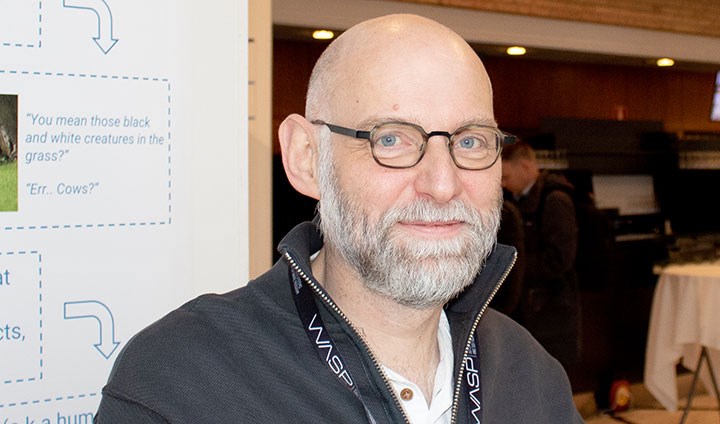New visiting professor – excellent addition to AI research

Luc De Raedt at the WASP-AI conference
“Artificial intelligence has to be able to both reason and learn new things. What I particularly like is that Örebro University is strong in both these areas. I’m looking forward to further collaboration with researchers here”, says Luc De Raedt, new visiting professor at Örebro University.
“Consider self-driving cars. They have to learn to recogonise pedestrians and where they usually are. But these cars must also be able to reason about who has the right of way and how to handle different traffic situations,” explains Luc De Raedt, professor at KU Leuven in Belgium.
After his first visit to Örebro in 2014 as a lecturer, he has worked together with researchers from Örebro in an EU project. And since 1 January, Luc De Raedt is associated with Örebro University as visiting professor.
WASP-AI conference
Already during his first days in Örebro, he participated in a conference with the research programme WASP-AI (Wallenberg AI, Autonomous Systems and Software Program), to which Örebro University is a contributor.
“An impressive and unique programme worldwide, which I know other parts of Europe have their eyes on – among those Flanders,” comments Luc De Raedt on WASP-AI.
“The goal is that the programme should benefit Swedish industry and I like the vision focusing on excellent research. As a scientist that’s good to hear.”
In Örebro, he will work with applying both machine learning and reasoning AI in autonomous sensor systems.
“One example is reasoning about objects you cannot see. Systems need to know where objects are even if they don’t see them. It’s like games you play with young kids”, explains Luc De Raedt.
Children's games
Playing games like peekaboo or hiding a ball under a cup, children learn that although an object disappears behind another object, it still exists and is only hidden. Compare a self-driving pallet truck in a warehouse that “sees” another truck disappear behind a column – it must understand that the other truck still exists and that it will appear again. An easy task for humans, but a difficult one for artificial intelligence.
“Örebro has always been strong when it comes to assigning symbols to an object. To understand that pedestrians may come in many shapes and sizes and may look different in pictures or in a video,” says Luc De Raedt.
Add language to the equation – artificial intelligence needs to learn to link words to objects.
“Someone might not say ‘a cup of tea’, but instead just say the name of a specific sort of tea. AI needs to understand that they are one and the same.”
Broaden our research
Luc De Raedt will be coming back for Easter and spend 20 per cent of his time in Örebro.
“Luc will be an excellent addition to AASS as he will broaden our research in AI towards new fields and deepen our excellence. He’s no stranger to us, since we’ve worked together in several projects. That is why we are so confident that he is perfect for Örebro”, says Amy Loutfi, pro-vice-chancellor for artificial intelligence at Örebro University.
Text: Linda Harradine
Photo: Natalie Pintar
Translation: Jerry Gray
